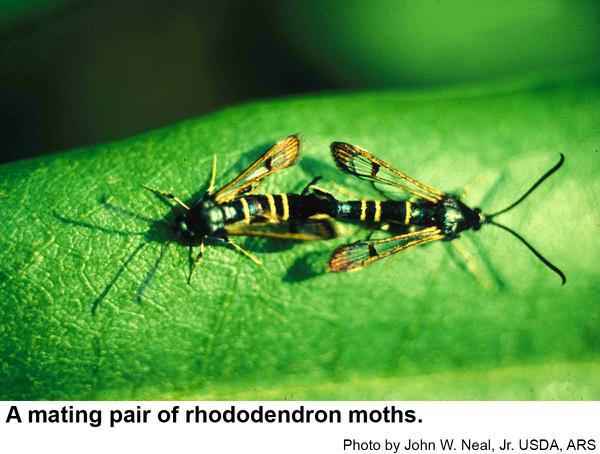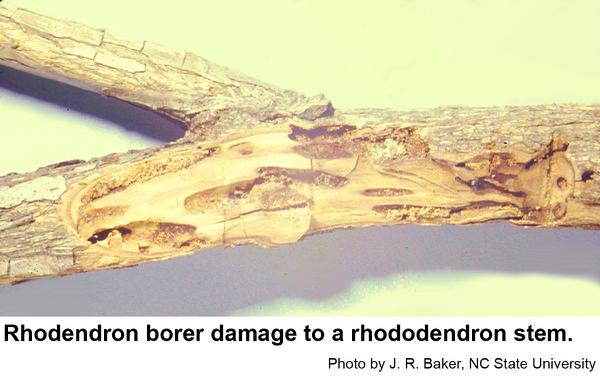Description and Biology
The adult rhododendron borer moth, Synanthedon rhododendri, is a small, black, slender moth with three narrow yellow bands across the abdomen. They are active in May and June. These moths lay up to 40 eggs each on the bark of rhododendrons, azaleas, and mountain laurels from which hatch tiny caterpillars that bore into the bark. These small caterpillars then bore into the sapwood and may cause the infested stem to wilt although larger stems may not. As the borers mature they grow to almost ½ inch long and are yellowish white with brown heads. The following spring, rhododendron borers cut exit holes that they plug with frass. They then spin a silk cocoon in the tunnel that incorporates some frass and bits of wood and pupate. Pupae are brown and slender. Two weeks or so later the next year's generation of moths emerges. We have one generation of rhododendron borers in North Carolina.
Host Plants
Rhododendron borers infest rhododendrons, azaleas (especially deciduous azaleas), and mountain laurels. Sometimes the first indication that a plant is infested is that infested stems break off when brushed against. Fast growing cultivars are especially vulnerable to the borers.
Residential Recommendations
Prune out and destroy heavily infested parts of the plants whenever wilting stems are noticed. Rhododendrons can be protected from further infestation by rhododendron borers by spraying the stems with one of the pyrethroid insecticides labeled for home landscape use. When used as directed, pyrethroids are very toxic to insects but are not particularly hazardous to humans and pets (other than fish-avoid using pyrethroids around pools, ponds, and streams). These are available in most big box stores, plant centers and nurseries. The first application should be made in mid April, May, or the first weeks in June. The most accurate way to time an application would be to use a pheromone-baited trap to lure males. When the first males are noticed, wait a week and then spray. Pheromone baits and traps are available through Gemplers (http://www.gemplers.com), Arbico Organics (http://www.arbico-organics.com) and other vendors.
References
- Insect and Related Pests of Shrubs. Baker, J. R. ed. 1980. NC Agricultural Extension Service publication AG-189. 199 pp.
- Plant Culture and Care, Insect and Disease Management. Anonymous. No Date. American Rhododendron Society.
- Rhododendron Borer, Synanthedon rhododendri (Beutenmuller). Hoover, G. Sr. 2001. Insect Advice from Extension. PennState College of Agricultural Sciences, Department of Entomology. Fact Sheets.
- Rhododendron Pest Management Calendar. Frank, S. D. and J. R. Baker, J. R. 2018. PDIC Factsheets, NC State Extension Publications.
- Seasonal Response of Six Male Sesiidae of Woody Ornamentals to Clearwing Borer (Lepidoptera: Sesiidae) Lure. Neal, J. W., Jr. and T. D Eichlen. 1983. Environmental Entomology 12: 206-209.
- Timing Insecticide Control of Rhododendron Borer with Pheromone Trap Catches of Males. Neal, J. W. Jr. 1981. Environmental Entomology 10 (2): 264-266.
- Extension Plant Pathology Publications and Factsheets
- Horticultural Science Publications
- North Carolina Agricultural Chemicals Manual
For assistance with a specific problem, contact your local Cooperative Extension Center.
This Factsheet has not been peer reviewed.
Publication date: Jan. 23, 2017
Reviewed/Revised: Oct. 28, 2021
Recommendations for the use of agricultural chemicals are included in this publication as a convenience to the reader. The use of brand names and any mention or listing of commercial products or services in this publication does not imply endorsement by NC State University or N.C. A&T State University nor discrimination against similar products or services not mentioned. Individuals who use agricultural chemicals are responsible for ensuring that the intended use complies with current regulations and conforms to the product label. Be sure to obtain current information about usage regulations and examine a current product label before applying any chemical. For assistance, contact your local N.C. Cooperative Extension county center.
N.C. Cooperative Extension prohibits discrimination and harassment regardless of age, color, disability, family and marital status, gender identity, national origin, political beliefs, race, religion, sex (including pregnancy), sexual orientation and veteran status.




